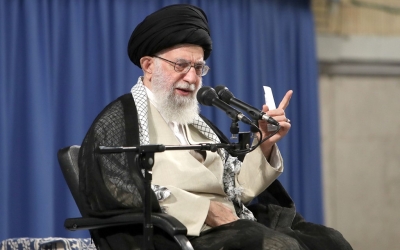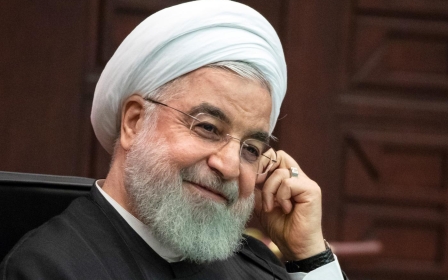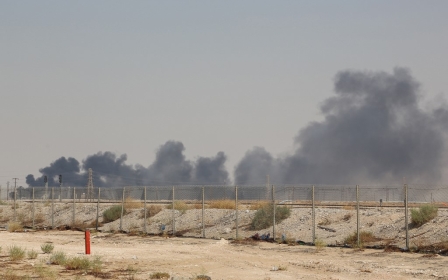Why the US will not win a war with Iran

The dramatic attack last Saturday on two major Saudi oil facilities has underscored the supercharged tensions that run across much of the region.
The attacks on the Abqaiq and Khurais oil facilities, run by the state-owned Aramco, have touched off a flurry of speculation about imminent military reprisals.
US officials, notably Secretary of State Mike Pompeo, lost no time in attributing the attacks to Iran. Vice President Mike Pence gave a bullish speech, where in true Trumpian fashion, he claimed the US is “locked and loaded” to defend its interests and those of its allies.
Slow-motion escalation
Yet, while regional tensions have reached a point where several rounds of direct hostilities may be inevitable, a fully fledged war between Iran and the US remains unlikely.
New MEE newsletter: Jerusalem Dispatch
Sign up to get the latest insights and analysis on Israel-Palestine, alongside Turkey Unpacked and other MEE newsletters
The slow-motion escalation since the summer might be immediately attributable to the Trump administration’s “maximum pressure” campaign against Iran, but its real causes are much deeper. There has been a shift in the regional balance of power, and Iran has reached the point of no return in terms of displacing the US as the dominant regional power.
Iran has reached the point of no return in terms of displacing the US as the dominant regional power
US President Donald Trump’s approach and policies have speeded up this process, creating the conditions for a clash.
While the shape, scale and trajectory of the looming confrontation is difficult to imagine in detail, one thing is certain: Iran holds the advantage at the political, diplomatic, informational and even military domain.
In trying to understand the situation, it is helpful to examine the foundational constructs of Iran-US relations over the past four decades. While it is no secret that Iran and the US have been bitter rivals since the Iranian revolution of 1979, what is less understood is the complex set of implicit protocols that have guided bilateral relations since then.
Despite the intense strategic rivalry in the region, especially in the Gulf arena, Iran and the US have generally avoided military conflict, with one notable exception. Operation Praying Mantis in April 1988, during the closing stages of the Iran-Iraq War, was a fierce one-day naval battle, during which the US destroyed a significant portion of the Iranian navy. The US navy regards the battle as its biggest engagement since the Second World War.
A timeline of US-Iran tensions
+ Show - HideTensions have skyrocketed between the Washington and Tehran since US President Donald Trump announced last May that he was pulling out of the 2015 Iranian nuclear deal.
Here's a timeline of key events that have led to, and marked, the recent escalation:
8 May 2018: US President Donald Trump announces plans to pull out of a 2015 nuclear deal with Iran. Under that agreement, the Iranian government agreed to curb its nuclear programme in exchange for a lifting of international sanctions.
Trump also says Washington will reimpose "the highest levels of economic sanctions" on Tehran.
5 November 2018: The US reimposes sanctions on Iran's oil, banking and transport sectors. At the same time, Trump says he wants to gradually impose sanctions on the Iranian oil industry, citing concerns about upsetting energy markets and causing global price spikes.
8 April: The Trump administration blacklists Iran's elite military force, the Islamic Revolutionary Guard Corps (IRGC). The move marks the first time Washington has formally labelled another country's military a terrorist group.
30 April: Iranian President Hassan Rouhani signs a bill into law that declares all US troops in the Middle East as terrorists, and defines the US as a state-sponsor of terrorism.
2 May: The US stops issuing waivers to countries that import oil from Iran. Those waivers had allowed certain states, including Turkey, China, Japan, India and South Korea, to keep buying Iranian oil, despite American sanctions - and provided a lifeline for Tehran.
6 May: US National Security Adviser John Bolton announces that the Trump administration is deploying an aircraft carrier, as well as ships and bombers, to the Gulf. The move was meant to send a "clear and unmistakable message" to the Iranian government, Bolton said, amid intelligence reports that Tehran was planning attacks against American troops in the region.
7 May: Iran says it plans to withdraw from parts of the 2015 nuclear agreement with major world powers. The move comes one year after US President Donald Trump withdrew from the deal.
8 May: The Trump administration announces a new round of economic sanctions that will target Iran's metals trade - iron, steel, aluminium and copper, specifically.
9 May: As the drums of war began to beat louder in certain circles in Washington, Trump tells reporters that he "would like to see them [Iran] call me" - a sign the US president is perhaps seeking to de-escalate the situation.
12 May: The United Arab Emirates says four oil tankers were damaged in "acts of sabotage" off the coast of Fujairah, just outside the Strait of Hormuz. The UAE did not assign blame for the incident, but said it would launch an investigation into what happened.
13 May: Mike Pompeo makes a surprise visit to Brussels, where he seeks to get European leaders on board with Washington's "maximum pressure" strategy against Tehran. The US secretary of state gets a lukewarm reception, however, with the European Union's foreign policy chief instead urging the US to show "maximum restraint".
14 May: Iran's Supreme Leader Ali Khamenei says the country will not go to war with the US. "Neither we nor they - who know war will not be in their interest - are after war," Khamenei says.
15 May: Anwar Gargash, the UAE's minister of state for foreign affairs, says the country is committed to "de-escalation" with Iran, while refusing to assign blame for the 12 May "sabotage" of the oil tankers.
That same day, the US orders non-emergency government employees to leave Iraq, citing fears of an imminent attack by Iranian-backed proxies in that country.
19 May: A Katyusha rocket is fired into Baghdad's Green Zone, an area that houses government offices and foreign diplomatic missions, including the US embassy in Iraq.
21 May: A previously unknown Iraqi group claims responsibility for the rocket fired into the Green Zone. The Operations of Martyr Ali Mansour says the attack is retaliation for Trump's decision to pardon a soldier who killed an Iraqi detainee in 2009.
24 May: Washington announces plans to deploy 1,500 additional troops to the Middle East to counter Iranian threats, a decision Iran blasted as "extremely dangerous".
28 May: US National Security Adviser John Bolton says the attack on four vessels off the Emirati coast was caused by "naval mines almost certainly from Iran".
30 May-1 June: Saudi Arabia hosts a summit in Mecca to discuss recent tensions with Iran. On the eve of the talks, Riyadh blasts what it called Iranian "interference" in the region and demanded "firmness" over attacks in the Gulf.
7 June: The US imposes sanctions on Iran's largest petrochemicals holding group, accusing Persian Gulf Petrochemical Industries Company of providing financial support to an engineering firm with ties to the IRGC.
13 June: Two oil tankers suffer damage after an unspecified attack in the Gulf of Oman. Hours after the incident, US Secretary of State Mike Pompeo points the finger at Iran, without providing evidence to back up his claim.
Iran immediately denies it was involved in the attacks.
14 June: The head of the United Nations calls for an independent investigation into the incidents in the Gulf of Oman.
Earlier in the day, US Central Command releases a video that it says shows Iranian IRGC members removing an unexploded mine from one of the damaged ships. That comes after Trump himself says the incident has Iran "written all over it".
Meanwhile, the owner of the Japanese vessel says crew members reported seeing objects flying towards them - which would appear to refute the US's version of events.
17 June: The US will send roughly 1,000 additional troops to the Middle East, Defense Secretary Patrick Shanahan announces.
20 June: Iran says it shot down a US military drone entering Iranian airspace near the Straits of Hormuz. A US official confirms that a drone was shot down but says it was in international airspace.
21 June: US President Donald Trump says he ordered and then aborted a military strike on Iran roughly 10 minutes before the operation took place.
Trump says he called off the strike after US generals reportedly told him the attack would kill 150 Iranians. The US operation was "not proportionate", the US president says.
24 June: The US imposes a new round of sanctions on Iran, this time targeting the country's supreme leader, Ayatollah Ali Khamenei.
25 June: Trump threatens Iran with "obliteration" if the country were to strike American targets. His comments come after Iranian President Hassan Rouhani called the White House "mentally retarded" and vowed that Tehran would not back down from US sanctions.
28 June: The US Senate votes down an amendment that sought to bar Trump from being able to declare war on Iran without authorisation from Congress.
4 July: A supertanker suspected of carrying Iranian crude oil to Syria in violation of EU sanctions is detained in Gibraltar. Senior Iranian officials deny claims the tanker was headed to Syria.
5 July: A senior Islamic Revolutionary Guard Corps (IRGC) commander suggests that Iran should seize a British oil tanker if the Iranian vessel detained off Gibraltar is not released immediately.
9 July: General Joseph Dunford, a top US general, announces plans to set up a coalition of allied countries willing to patrol key waterways in the Gulf region.
Dunford says the US military would provide command ships and surveillance technology, while its allies would escort ships and patrol the Strait of Hormuz and Bab el-Mandeb.
11 July: British officials say three Iranian boats attempted to "impede the passage" of a British oil tanker in Gulf waters, forcing a UK warship to intervene. Iran denies the accusation.
Meanwhile, Gibraltar police announce the arrest of the captain and chief officer of the Iranian supertanker on suspicion that the ship had breached EU sanctions on Syria on 4 July.
12 July: US lawmakers approve a measure that would force President Donald Trump to seek congressional approval before ordering military strikes against Iran.
16 July: Iran says it has ruled out entering into negotiations over its ballistic missile programme, directly contradicting statements made by US Secretary of State Mike Pompeo earlier that same day.
18 July: Trump says American warship USS Boxer downed an Iranian drone in the Strait of Hormuz. But top Iranian officials deny the report.
31 July: Washington imposes sanctions on Iran's Foreign Minister Zarif. Zarif tells Saudi Arabia that Iran is "ready for dialogue".
5 August: The UK becomes the first country to join Washington's maritime security mission in the Gulf.
8 August: Iran's defence minister warns of "disastrous repercussions" if Israel were to join the US maritime security coalition in the Gulf.
15 August: The US Justice Department issues a warrant for Iran's Grace 1 after Gibraltar says it is ready to release the tanker.
18 August: The Grace 1, renamed the Adrian Darya-1, is released from Gibraltar after a five-week standoff.
19 August: Bahrain joins the US-led mission in Gulf waters.
21 August: Australia becomes the third country to join Washington's maritime security mission in the Gulf.
27 August: US President Donald Trump and Iranian Foreign Minister Mohammad Javad Zarif both attended the G7 conference but do not meet.
28 August: The US Treasury Department issues sanctions against two networks it says are tied to Iran's missile proliferation programme. Meanwhile, the US's joint maritime security initiative in the Gulf officially launches.
3 September: France says it is prepared to offer Iran $15bn in credit lines to help ease Washington's economic pressure against the country - but the proposal hinders on US approval.
4 September: Iran's President Hassan Rouhani gives European powers another two months to save the 2015 nuclear deal, but warns that Iran is still preparing to breach the pact in ways that would have "extraordinary effects".
6 September: Two sources tell MEE that the Iranian oil tanker that was held by British authorities in Gibraltar for five weeks has delivered its cargo to Syria.
10 September: US President Donald Trump sacks national security adviser John Bolton, seen as the architect of recent US-Iran tensions. Meanwhile, the UK says Iran broke its promise by transferring oil to Syria aboard the Adrian Darya I several weeks after Gibraltar released the supertanker.
14 September: A coordinated drone attack strikes the heart of the Saudi oil industry, forcing the kingdom to shut down about half of its crude production.
The Houthi rebels claim responsibility, but US Secretary of State Mike Pompeo accuses Iran of leading the attack. Iran denies this.
15 September: The commander of Iran's Revolutionary Guards Corps Aerospace Force, Amir Ali Hajizadeh, says that all US bases and aircraft carriers in the Middle East are within range of Iranian missiles
A senior Iraqi intelligence official tells Middle East Eye that the Saudi strikes were carried out by Iranian drones launched from Hashd al-Shaabi militia bases in southern Iraq.
16 September: President Donald Trump says the US was "locked and loaded" against Iran and he was "waiting to hear from the kingdom as to who they believe was the cause of this attack, and under what terms we would proceed!"
17 September: US Vice President Mike Pence warns Tehran that Washington is ready for military confrontation and will not ease its pressure campaign against the Islamic Republic.
18 September: Saudi Arabia says there was "unquestionable evidence" that the attack on its oil facilities was sponsored by Iran and was launched from the north of the kingdom.
19 September: Iranian Foreign Minister Mohammad Javad Zarif says Iran does not want war, but warns the US that any attack on Iran would lead to "all-out war".
US Secretary of State Mike Pompeo responds to Zarif's comments, saying that Washington was searching for a peaceful solution to the conflict.
But Praying Mantis was the exception that proved the rule. Since the end of the Iran-Iraq War, there hasn’t been a single military encounter between the two powers, despite repeated provocations by both sides.
Belligerent posturing
This has given rise to an implicit doctrine that can best be described as “no war no peace”, whose foundational concepts have, broadly speaking, served the interests of all key stakeholders.
Iran and the US have both benefited from the standoff, which has allowed both powers to adopt a belligerent posture in the Middle East without coming to blows. This has created space for them to protect their interests and consolidate influence, without touching off serious regional instability.
It has also allowed for rare instances of highly qualified cooperation, notably in the battle against the Islamic State group in Iraq. But the unacknowledged doctrine of “no war no peace” has come under increasing strain in recent years, and it is now fast approaching the point of expiry.
In trying to understand why the rubric of Iran-US relations is coming apart, it is worthwhile examining what both sides have understood about the “no war no peace” doctrine, and specifically about its longevity.
To the Iranians, the guiding principle of foreign policy in the past three decades, since the end of the Iran-Iraq War, has been to balance the requirement of capacity-building with sustaining revolutionary ideology.
In practice, this has translated to developing a vast network of influence in the Middle East by partnering with deeply entrenched local groups and communities, stretching from Lebanon to Yemen, while avoiding inter-state conflict.
Deep-rooted misunderstandings
To the Americans, deep-rooted misunderstandings about the nature, complexity, ambitions, dexterity and resilience of the Islamic Republic helped sustain the “no war no peace” doctrine.
In the past 30 years, both Republican and Democratic US administrations have made two basic assumptions about Iran: that its revolutionary ideology would fizzle out over time, and that its strategic momentum would hit a ceiling, ushering in a transition from “revolutionary” power to “normal” state.
Veteran US diplomat and strategist Henry Kissinger elucidated this misunderstanding perfectly when he pontificated that at some point, Iran would have to choose between being a “country” or a “cause”.
But the US has more or less given up on its assumptions and expectations. The outcome of the Syria conflict has been pivotal to the subversion of the US calculus, with Iran showcasing a broad range of military, intelligence, political and diplomatic skills in winning the war, against all expectations.
Former British diplomat and Arabist Sir John Jenkins showed a good understanding of strategic US miscalculations when he insightfully observed that Iran is now more prepared for war than any other regional or extra-regional state. But for all his diplomatic skills and experience, Jenkins got it fatally wrong in the advice he now offers the US: to adopt a more muscular posture towards Iran, or as he cleverly put it, to stop “appeasing” the Islamic Republic.
That’s the path to a war, which the US and its allies, notably the UK, will lose.
Mixed messaging
Much has been written about Trump’s “maximum pressure” campaign against Iran and the underlying logic (or lack thereof) driving it. Yet, while the current US administration appears to be genuinely confused, resulting in mixed and incoherent messaging, this should not be mistaken for the US establishment as a whole.
The key foreign policy institutions of the US - the CIA, the Pentagon and the State Department - appear to have achieved consensus on collapsing the old framework that had sustained tense bilateral relations for three decades.
As this summer’s events have demonstrated, Iran is more than ready for war, for one simple reason: it has high confidence it can win.
While there is obviously a sharp hard power disparity between Iran and the US, the simple truth (as the US knows too well) is that it will count little towards the outcome of the war, and more importantly to post-conflict strategic rebalancing.
In the critical areas of asymmetric conflict, intelligence, information operations and proxy warfare, Iran’s skills and capabilities are superior to the core Western powers, such as the US and UK.
Furthermore, notwithstanding four decades of maturity, the Islamic Republic remains at its core an authentic revolutionary power with a massive regional constituency. Any direct military conflict between Iran and the US - no matter how limited by scope or duration - will mobilise this constituency not just for great strategic effect, but for a massive strategic transformation.
Worse than Vietnam?
It is no exaggeration to say that the survival of ruling regimes in Saudi Arabia and the United Arab Emirates will be at stake during any prolonged or protracted conflict between Iran and the US. The conflict will also affect the greater Levant area, where Lebanon’s Hezbollah is more than ready to sustain a massive conflict with Israel.
But whether that conflict comes to pass depends to a great extent on the choices of Israeli leaders, as opposed to instigation by Iran’s allies on the Eastern Mediterranean.
If it continues on the current trajectory, the US is poised to suffer its greatest defeat in living memory
For US leaders, it is not too late to avoid these deeply unattractive scenarios. Only the White House can de-escalate at this point, by calling off its campaign of “maximum pressure” - which only yields “maximum resistance” from the opposing side - or failing that, to at least moderate it with off-ramps.
If it continues on the current trajectory, the US is poised to suffer its greatest defeat in living memory - a much harsher setback than Vietnam, both in strategic and psychological terms.
To subvert Kissinger’s maxim, the choice confronting US leaders and strategists is whether they want to keep up the pretence of superpower status for a couple of decades longer, or risk getting an almighty bloody nose from Iran and its allies.
The views expressed in this article belong to the author and do not necessarily reflect the editorial policy of Middle East Eye.
This article is available in French on Middle East Eye French edition.
Middle East Eye delivers independent and unrivalled coverage and analysis of the Middle East, North Africa and beyond. To learn more about republishing this content and the associated fees, please fill out this form. More about MEE can be found here.








